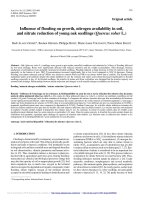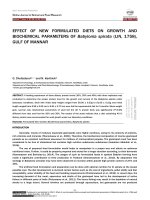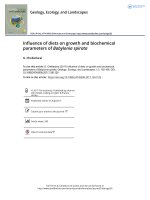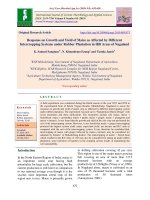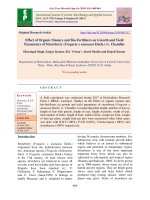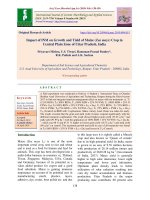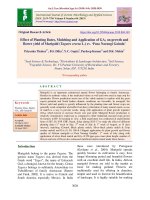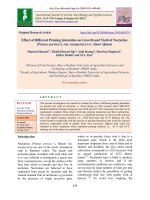Influence of diets on growth and biochemical p
Bạn đang xem bản rút gọn của tài liệu. Xem và tải ngay bản đầy đủ của tài liệu tại đây (711.39 KB, 6 trang )
Geology, Ecology, and Landscapes
ISSN: (Print) 2474-9508 (Online) Journal homepage: />
Influence of diets on growth and biochemical
parameters of Babylonia spirata
G. Chelladurai
To cite this article: G. Chelladurai (2017) Influence of diets on growth and biochemical
parameters of Babylonia�spirata, Geology, Ecology, and Landscapes, 1:3, 162-166, DOI:
10.1080/24749508.2017.1361129
To link to this article: />
© 2017 The Author(s). Published by Informa
UK Limited, trading as Taylor & Francis
Group
Published online: 07 Aug 2017.
Submit your article to this journal
Article views: 245
View Crossmark data
Full Terms & Conditions of access and use can be found at
/>
Geology, Ecology, and Landscapes, 2017
VOL. 1, NO. 3, 162–166
/>
INWASCON
OPEN ACCESS
Influence of diets on growth and biochemical parameters of Babylonia spirata
G. Chelladurai
Department of Zoology, G. Venkataswamy Naidu College, Kovilpatti, India
ABSTRACT
A feeding experiment of three dietary protein levels (30, 35 and 40%) with three replicates was
conducted to determine the proper protein level for the growth and survival of the Babylonia
spirata under laboratory conditions. Snail with initial body weight ranged from 50.95 ± 0.33 g to
51.05 ± 0.21 g and initial length ranged from 5.96 ± 0.62 cm to 6.91 ± 0.70 cm were fed as the
experimental diet for 3 months. Mean weight gain, survival rate and biochemical parameters of
snail fed the 40% protein diets was significantly (p < 0.05) different from that snail fed the 30 and
35% protein diets. The results of the study indicate that a diet containing 40% dietary protein
was recommended for snail growth under our laboratory conditions.
1. Introduction
Since ancient times, the finfish and shellfish have been
noted as the rich protein source for mankind, all over the
world. Besides, proteins source they also delivers various
minerals and vitamins, with its own characteristic taste.
Moreover, fish meat seems to contain significantly low
lipids and higher water content than beef or chicken, it
has been favoured over other white or red meats (Nestel,
2000). Malnutrition is considered as a serious problem
and is being faced by many developing countries. In
India, 20–30% of the population does not get adequate
nutrition. This problem could be easily solved by effective utilization of nutrient-rich molluscs. This means that
the proper exploitation of capture fishery and culture
fishery would surely supply the balanced nutritious food
and thereby, it controls the malnutrition problem.
Generally, meats of molluscs, especially gastropods
were highly nutritious, owing to its contents of proteins,
rich vitamins and minerals (Thanonkaew, Benjakul, &
Visessanguan, 2006). Therefore, the biochemical composition of marine gastropod persists as an excellent
nutritional assurance for millions of malnourished
peoples. The gastropod meat has been considered to be
free of cholesterol but contains high nutritive substances
(Abdullah, Nurjanah, Hidayat, & Gifari, 2016).
The use of prepared feed formulation would helps
to manipulate in a proper way and obtain an optimum
nutritional value. Further, it could be properly prepared and stored for a longer duration according, to
their demands (Nyameasem & Borketey-La, 2014). The
usages of, such as formulated feeds in spotted Babylon
CONTACT G. Chelladurai
ARTICLE HISTORY
Received 14 June 2017
Accepted 25 July 2017
KEYWORDS
Formulated diet; growth;
biochemical parameters;
Babylonia spirata
farming have made a significant contribution to their
production in Thailand (Chaitanawisuti, Rodruang, &
Piyatiratitivorakul, 2010). By adaptation, this strategy in
Babylonia areolata may have been observed to increase
within growth high protein content of 27 and 45%.
The artificial feed formulation and preparation can be
done with optimal nutrition for Babylonia spirata at the
lowest possible cost. The diet development is involved
in certain factors, such as the cost of ingredients, pellet ability and diet acceptability, water stability of the
feed and handling requirements (Chaitanawisuti et al.,
2010). In recent days, the increasing demand of the meat,
operculum and shells of the gastropod have led to the
development of active fishery in different parts of India
(Periyasamy, Srinivasan, Devanathan, & Balakrishnan,
2011). The heavy fishing may result in the depletion
of natural stocks to a large extent. Several bivalves are
produced through aquaculture, but gastropods are not
produced through aquaculture and they can also be cultured for commercial production. Only a few studies
were done in India on breeding, larval rearing and sea
ranching of gastropods (Mohanraj et al., 2010). A few
studies have only been conducted in the commercially
important gastropods. However, information on the
gastropod species of commercial (ornamental) interest
from the Indian coast remains scarce. In recent days,
the increasing export value of the meat, operculum and
shells of the gastropods have led to the development of
active fishery in different parts of India. Several bivalves
have been produced through aquaculture. The present
study deals with the work, influence of formulated diets
on growth and biochemical parameters of B. spirata.
© 2017 The Author(s). Published by Informa UK Limited, trading as Taylor & Francis Group.
This is an Open Access article distributed under the terms of the Creative Commons Attribution License ( which permits unrestricted
use, distribution, and reproduction in any medium, provided the original work is properly cited.
GEOLOGY, ECOLOGY, AND LANDSCAPES
2. Materials and methods
The samples of B. spirata with their initial weight ranged
from 50.68 to 52.52 g and initial length ranged from
5.53 to 5.82 cm were collected at the Therespuram
coastal area (80° 48′N; 78° 94′E), Tuticorin, south-east
coast of India. Collected samples were made to acclimatize in 7 days using aerated plastic holding tanks
(1.5 m × 2 m × 0.5 mL: W:H) in the Marine Gastropod
Hatchery Research Laboratory, Kamaraj College,
Tuticorin, Tamil Nadu, India. During this study period,
the snails were fed with natural live clam meat. Then
they were randomly distributed into triplicate FRP tank
containing 200 L at 40 snail/tank and three experimental groups were maintained. The tanks were regularly
cleaned, disinfected and allowed to dry for 24 h after
which they were filled with dechlorinated ambient seawater to 2/3 sizes of the tanks. The bottom of the rearing tanks was covered with 3 cm layer of coarse sand
(500–1000 micron mean grain size) as substrate. After
removing the snails from culture tanks, sand was cleaned
using a water jet flushing and sun-dried at 30 days intervals in order to remove the accumulated waste materials.
During this period, the snails were fed with formulated
(30, 35 and 40% crude protein) at once day. The total
experiment was conducted for 90 days.
The procedures for feed preparation were modified by
Hardy (1980). The feed ingredients were homogenized
thoroughly in a food mixer. After adding distilled water
to the mixed ingredients, a paste was made using a hand
mixer. The paste was shaped into 0.5 mm thick sheets
and they were cut into 2 cm2 flakes, sealed in a plastic
bag and stored at −20 °C. The experimental diets were
formulated with the composition protein of 30, 35 and
40%. The fish meal and groundnut oil cake serves as the
protein source, fish oil serves as the lipid source, tapioca
Table 1. Composition of basal diet.
3
4
5
6
S. no.
1
2
3
4
5
abc
powder serves as the carbohydrate source, wheat flour
serves as a binder and vitamin and mineral mixtures
were also added (Table 1).
2.2. Water quality
The seawater quality parameter was analysed weekly for
its purity. It includes parameters, like temperature (°C),
salinity (ppt), pH and dissolved oxygen (mg/L) were
examined using SYSTRONICS water analyser 371.
2.3. Growth parameters
The growth performance and biochemical profile were
expressed in terms of weight measurements, like weight
gain (g) and survival (%) were monitored according
following formula of Chaitanawisuti, Choeychom, and
Piyatiratitivorakul (2011).
Weight gain (g) = Final weight –Initial weight
Survival (%) =
F2
× 100
F1
F1 – Number of snail at the being of experiment.
F2 – Number of snail at the end of the experiment.
2.4. Estimation of biochemical profile
2.1. Experimental diet
S. no.
1
2
163
Ingredients
Fish meal
Groundnut
oil cake
Tapioca
Maida
Cod liver oil
Vitamin and
minerals
mix
30%
26
26
35%
32
32
40%
38
38
23
23
1
1
17
17
1
1
11
11
1
1
Proximate
composition
Moisture
Protein
Carbohydrate
Fat
Ash
30%
35%
40%
74.26 ± 0.26a
30.45 ± 0.47b
10.87 ± 0.96c
74.96 ± 0.78b
34.63 ± 0.19b
10.96 ± 0.46ac
75.12 ± 0.15a
39.17 ± 0.31a
11.05 ± 0.24c
2.16 ± 0.44d
8.11 ± 0.78e
2.20 ± 0.63b
8.13 ± 0.75bc
2.54±0.10c
8.23 ± 0.84c
(Mean ± SD) the same letter in the same row is not significantly different
at p < 0.05.
The Folin–Ciocallteu phenol method of Lowry,
Rosebrough, Farr, and Randall (1951) was adopted for
the estimation of total protein in the tissue. Total carbohydrate content method was followed by DuBois, Gilles,
Hamilton, Rebers, and Smith (1956). The lipid content
was estimated gravimetrically by following the method
of Floch, Lees, and Sloane-Stanley (1956). The moisture
and ash content was followed by AOAC (1990).
2.5. Statistical analysis
All experimental data obtained were analysed using oneway analysis of variance (ANOVA) followed by Duncan’s
multiple range test p < 0.05 was considered for describing the significant level (SPSS Version 20).
3. Results and discussion
The aquaculture of molluscs seems to be seriously
affected worldwide by bacterial pathogens and predators’ that cause high losses in hatcheries as well as in
natural beds. The main responsible for the mortality
outbreaks is a number of Vibriosp and Aeromonas
species that are considered as important pathogens in
aquaculture (Chen, Ke, Zhou, & Li, 2005). The pathologies caused by Vibrio in bivalves and gastropods have
been described since the 1960s; however, over recent
years successive episodes of high mortality have been
recorded due to these microorganisms. The average
shell length and weight and survival rate of B. spirata
164
G. CHELLADURAI
fed with formulated diet for three months are shown
in Table 2. The growth expressed as body weight, shell
length and survival rate were significantly not different
p < 0.05 among the experiment diets. Among the average body weight gain, the highest was observed at 40%
level of protein diet (2.14 ± 0.84 g) and the lowest was
observed at 30% level of protein diet (1.01 ± 0.36 g). In
average final shell length, the highest was observed at
40% diet (6.91 ± 0.70 cm) and the lowest was observed
at 30% diet (5.96 ± 0.62 cm). The average survival
rate, the highest was observed at 40% of protein diet
(91 ± 1.04%) and the lowest was observed at 30% diet
(89 ± 1.06%). The maximum growth and survival
rate were observed in 40% protein diet. According
to Chaitanawisuti, Kritsanapuntu, and Santaweesuk
(2010), have reported B. areolata is one of the most
important cultivable species with significant commercial value. Currently, the most common practice
is spotted in Babylon culture in Thailand. Similarly,
Chaitanawisuti and Kritsanapuntu (2000) have reported
that average growth rate of juvenile spotted Babylon of
B. areolata was 3.86 mm mo−1 in length and 1.47 mo−1
in weight after 8 months when cultured at a density of
300 snails/m2 in flow through system and 3.21 mm mo−1
and 1.10 g mo−1 when held in a recirculation system.
Sirusa Kritsanapuntu et al., (2013) reported the partial
replacement of tuna oil by corn oil in formulated diets
of B. areolata under hatchery conditions have no effects
on growth performance but fat content of the whole
body reduced to half than those contained in formulated diets. Recently, Jayalakshmi (2016) have reported
that the edible body tissue of Babylonia sp. an excellent
source of high protein, low lipid content but enriched
with essential vitamins and minerals. It is can be taken
regularly as animal protein supplement or nutritive seafood which supplies all vital nutrients for the growing
children, pregnant women and people suffering from
malnutrition. Temperature and salinity are considered
to be the most important physical factors influencing
marine organisms and the biological effects of these factors are complex and wide ranging. Secondly, temperature affects the hatch rate, incubation period, the size
of the newly hatched larvae, larval yolk absorption and
utilization, larval feeding behaviour, larval survival and
larval growth (Shi, Zhang, Zhu, Liu, & Zang, 2010). The
temperature, salinity, diet and rearing density are exogenous factors affecting larval growth, settlement and
metamorphosis Crisp (1974). The average water quality
parameters observed during the experimental period
for 12 weeks are shown in Tables 3a–3c. These parameters were significantly p < 0.05 different, including the
temperature which ranged between 26.66 ± 0.57 °C and
27.68 ± 0.30 °C, the salinity between 32.12 ± 0.37 ppt
and 33.92 ± 0.77 ppt, the pH from 7.60 ± 0.46 to
7.83 ± 0.49 and the dissolved oxygen from 5.41 ± 0.36
to 6.21 ± 0.47 mg/L. These values are suitable for rearing
of B. spirata. Similarly, Kritsanapuntu, Chaitanawisuti,
Santhaweesuk, and Natsukari (2006) observed the
higher body weight gain and shell length increments
were observed in B. areolata held in recalculating seawater system at water exchange of 15 day intervals.
The proximate compositions of B. spirata tissues fed
with different formulated diet are shown in the Table 4.
The maximum moisture content (80.17 ± 0.19%), protein (50.61 ± 0.61), carbohydrate (15.41 ± 0.84), lipids
(4.09 ± 0.03) and ash (15.66 ± 0.57) was recorded in
40% of protein diet and minimum in 30% protein det.
All the above proximate values are (p < 0.05) not significantly different. Palpandi, Vairamani, and Shanmugam
(2010) have reported the proximate composition of
Cymbiummelo. Among proximate composition, protein ranged from 20.78 to 30.19%, carbohydrate 5.14
to 2.59%, lipid 3.39 to 2.76% and moisture content
83.69 to 76.59%. Similarly, Periyasamy et al. (2011) has
reported that B. spirata meat is a valuable food with
high-quality protein and well-balanced diet. Nutritional
contents of protein (53.86%), carbohydrate (16.85%)
and lipid (9.30%) Sini Margret and Jansi (2013) have
also observed the biochemical composition of four
important gastropods from Kanyakumari coast. The
maximum protein content was observed in B. spirata
(39.8%) and B. zeylancia (35.8%).
4. Conclusion
In conclusion, this study showed that the formulated
diet can be readily used for B. spirata growout for maximizing growth, survival and biochemical parameters.
However, further research is needed to improve the
immunomodualtion activity of snail fed with herbal
based supplement diets under intensive culture.
Acknowledgements
I wish to thank the authorities of Kamaraj College for providing the necessary facilities, and the Centre for Marine Living
Resources and Ecology (CMLRE), Government of India for
carrying out studies on molluscs culture.
Table 2. Average length, weight and survival rate of B. spirata fed with (30, 35 and 40%) different formulated diets for 3 months.
Diets
(30%)
(35%)
(40%)
Initial weight (g)
50.95 ± 0.33a
50.16 ± 0.12ab
51.05 ± 0.21a
Final weight (g)
51.96 ± 0.32ba
51.63 ± 0.15b
53.45 ± 0.24b
Weight gain (g)
1.01 ± 0.36ca
1.47 ± 0.55c
2.14 ± 0.84cab
(Mean±SD) the same letter in the same row is not significantly different at p < 0.05.
abc
Initial length (cm)
5.56 ± 0.63a
5.79 ± 0.45ab
5.81 ± 0.41a
Final length (cm)
5.96 ± 0.62ba
6.59 ± 0.45b
6.91 ± 0.70ba
Survival (%)
89 ± 1.06ca
90 ± 1.23cb
91 ± 1.04ca
GEOLOGY, ECOLOGY, AND LANDSCAPES
165
Table 3a. Average water quality parameters observed during experimental period of (12 weeks) in B. spirata at 30% of basal diet.
Weeks
1
2
3
4
5
6
7
8
9
10
11
12
Temperature (°C)
26.32 ± 0.74a
26.90 ± 0.98ab
27.12 ± 0.30a
27.00 ± 0.94a
27.96 ± 0.73abc
26.85 ± 0.86a
27.12 ± 0.81a
26.08 ± 0.37a
27.03 ± 0.44ac
26.97 ± 0.42a
27.06 ± 0.83a
26.05 ± 0.50a
Salinity (ppt)
33.04 ± 0.25b
32.66 ± 0.58b
33.19 ± 0.21a
33.92 ± 0.77ba
32.53 ± 0.51b
33.13 ± 0.48b
32.16 ± 0.19b
33.26 ± 0.14ba
33.62 ± 0.37bc
33.07 ± 0.43ba
33.52 ± 0.31b
32.20 ± 0.39b
pH
7.21 ± 0.39ab
7.15 ± 0.14c
7.13 ± 0.21c
7.06 ± 0.11a
7.61 ± 0.78c
7.56 ± 0.11cab
7.10 ± 0.51cab
7.86 ± 0.95c
7.45 ± 0.61c
7.26 ± 0.07ca
8.03 ± 0.73ab
7.60 ± 0.46c
DO mg/L
5.30 ± 0.12d
5.13 ± 0.38d
5.06 ± 0.16a
5.16 ± 0.24a
5.05 ± 0.16dbc
6.02 ± 0.51d
5.26 ± 0.17dab
5.96 ± 0.63da
5.02 ± 0.37d
6.30 ± 0.12d
6.55 ± 0.47d
6.77 ± 0.61da
(Mean ± SD) the same letter in the same row is not significantly different at p < 0.05.
abcd
Table 3b. Average water quality parameters observed during experimental period of (12 weeks) in B. spirata at 35% of basal diet.
Weeks
1
2
3
4
5
6
7
8
9
10
11
12
Temperature (°C)
26.55 ± 0.17a
27.80 ± 0.12a
26.18 ± 0.29a
26.25 ± 0.52a
27.49 ± 0.69a
28.15 ± 0.19a
26.92 ± 0.29a
27.18 ± 0.29ab
27.03 ± 0.64ac
27.67 ± 0.62ac
27.11 ± 0.43a
26.85 ± 0.63a
Salinity (ppt)
32.60 ± 0.16ba
33.26 ± 0.62b
32.66 ± 0.63ba
32.92 ± 0.54b
32.63 ± 0.63ba
33.83 ± 0.19b
33.16 ± 0.26ba
33.90 ± 0.46b
33.62 ± 0.54bc
32.77 ± 0.29bc
32.50 ± 0.26b
33.08 ± 0.39ba
pH
7.16 ± 0.36ca
7.63 ± 0.24cab
7.27 ± 0.23cad
7.66 ± 0.19c
7.28 ± 0.45ca
7.16 ± 0.36ca
7.33 ± 0.24ca
7.60 ± 0.63cb
7.31 ± 0.45c
7.13 ± 0.64c
7.23 ± 0.27cad
7.20 ± 0.23c
DO mg/L
5.11 ± 0.13d
5.33 ± 0.48d
5.41 ± 0.26d
5.08 ± 0.24d
5.65 ± 0.66d
5.33 ± 0.71d
5.11 ± 0.67da
5.16 ± 0.43db
6.05 ± 0.27d
5.93 ± 0.12dc
6.21 ± 0.67d
6.07 ± 0.03d
(Mean ± SD) the same letter in the same row is not significantly different at p < 0.05.
abcd
Table 3c. Average water quality parameters observed during experimental period of (12 weeks) in B. spirata at 40% of basal diet.
Weeks
1
2
3
4
5
6
7
8
9
10
11
12
Temperature (°C)
26.66 ± 0.57a
27.30 ± 0.98a
27.68 ± 0.30a
27.45 ± 0.94a
27.49 ± 0.74a
27.55 ± 0.26a
27.42 ± 1.01a
26.78 ± 0.37a
26.93 ± 0.44a
27.67 ± 0.72a
26.81 ± 0.43a
26.85 ± 0.70a
Salinity (ppt)
33.00 ± 0.55ba
33.06 ± 0.58b
33.96 ± 1.01ba
33.92 ± 0.77b
33.53 ± 0.56b
32.93 ± 0.48b
32.46 ± 0.81ba
32.90 ± 0.54b
33.12 ± 0.37b
32.77 ± 0.43b
32.60 ± 0.41b
32.88 ± 0.39b
pH
7.82 ± 0.39ca
7.83 ± 0.54cab
7.83 ± 0.49ca
7.71 ± 0.51cab
7.63 ± 0.74ca
7.36 ± 0.41c
7.70 ± 0.61ca
7.80 ± 0.55ca
7.81 ± 0.41ca
7.83 ± 0.37c
7.63 ± 0.43ca
7.60 ± 0.46c
DO mg/L
5.41 ± 0.43d
5.53 ± 0.38d
5.41 ± 0.36da
5.78 ± 0.34d
5.45 ± 0.46da
5.93 ± 0.51da
5.61 ± 0.37d
5.66 ± 0.43da
5.45 ± 0.37d
5.93 ± 0.42da
6.21 ± 0.47da
6.07 ± 0.43da
(Mean ± SD) the same letter in the same row is not significantly different at p < 0.05.
abcd
Table 4. Proximate composition of formulated diet of B. spirata.
References
Proximate composition (%)
Moisture
Protein
Carbohydrate ate
Lipid
Ash
Abdullah, A., Nurjanah, N., Hidayat, T., & Gifari, A. (2016).
Characterize fatty acid of Babylonia spirata, Meretrix
meretrix, Pholas dactylus. International Journal of Chemical
and Biomolecular Science, 2, 38–42.
AOAC. (1990). Official method of analysis (15th ed.).
Washington: Association of Official Analytical Chemists.
Chaitanawisuti, N., & Kritsanapuntu, A. (2000). Growth and
production of hatchery reared juvenile spotted Babylon,
Babvloniaareolata, Link 1807 cultures to marketable size
in intensive flow through and semi-closed re-circulating
water systems. Aquaculture Research, 31, 415419.
Chaitanawisuti, N., Rodruang, C., & Piyatiratitivorakul, S.
(2010). Optimum dietary protein levels and protein to
energy ratios on growth and survival of juveniles spotted
Babylon (Babylonia areolata Link) under the recirculating
seawater conditions. International Journal of Fisheries and
Aquaculture, 2, 058–063.
30%
74.53 ± 0.06bac
46.12 ± 0.57bca
13.22 ± 0.74bac
4.02 ± 0.03bac
16.33 ± 1.15bac
35%
74.31 ± 0.19c
37.68 ± 0.55c
11.92 ± 0.17c
3.80 ± 0.02c
13.33 ± 1.52cac
40%
80.17 ± 0.19a
50.61 ± 0.61a
15.41 ± 0.84ac
4.09 ± 0.03ac
15.66 ± 0.57a
Disclosure statement
There is no conflict of interest to be declared by the author.
Funding
This work was supported by Centre for Marine Living
Resources and Ecology (CMLRE), Ministry of Earth Science,
Government of India [grant number MoES/10-MLR/01/12].
166
G. CHELLADURAI
Chaitanawisuti, N., Kritsanapuntu, S., & Santaweesuk, W.
(2010). Effects of water depth and water flow duration on
growth and survivalof juvenile spotted Babylon (Babylonia
areolata) cultured in a flow-through system. Journal of
Applied Aquaculture, 22, 11–17.
Chaitanawisuti, N., Choeychom, C., & Piyatiratitivorakul, S.
(2011). Effects of dietary supplementation of brewer’s yeast
and nucleotide diet on growth and vibriosis resistance
of hatchery-reared juvenile spotted babylon (Babylonia
areolata). Aquaculture International, 19, 489–496.
Chen, Y., Ke, C. H., Zhou, S. H., & Li, F. H. (2005). Effect
of food availability on feeding and growth of cultivated
Juvenile Babylonia formosaehabei. Aquaculture Research,
36, 94–99.
Crisp, D. J. (1974). Factors influencing the settlement of
marine invertebrate larvae. In P. T. Grant, & A. M. Mackie
(Eds.), Chemoreception in marine organisms (pp. 177–
263). New York, NY: Academic Press.
DuBois, M., Gilles, K., Hamilton, J. K., Rebers, P. A., & Smith,
F. S. (1956). Calorimetric method for determination of
sugars and related substances. Analytical Chemistry, 28,
350–356.
Floch, J., Lees, M., & Sloane-Stanley, G. H. (1956). A simple
method for the isolation and purification of total lipids from
animal tissues. Journal of Biological Chemistry, 226, 497–509.
Hardy, R. (1980). Fish feed formulation. In Fish Feed
Technology, Aquaculture development and coordination
Programme (pp. 233–239.12).
Jayalakshmi, K. (2016). Biochemical composition and
nutritional value of marine gastropod Babylonia zeylanica
from Puducherry, South east coast of India, Indo. Asian
Journal of Multidisciplinary Research, 2, 478–483.
Kritsanapuntu, S., Chaitanawisuti, N., & Santaweesuk, W.
(2013). Effects of dietary partial replacement of tuna oil
by corn oil in formulated diets for growth performance
and proximate composition of juvenile spotted babylon,
babylonia areolata under hatchery conditions. Journal of
Aquaculture Research and Development, 4(6), 1–4.
Kritsanapuntu, S., Chaitanawisuti, N., Santhaweesuk, W., &
Natsukari, Y. (2006). Growth, production and economic
evaluation for monoculture and polyculture of juvenile
spotted abylon (Babylonia areolata) to marketable sizes
using large-scale operation of earthen ponds. Journal of
Shellfish Research, 25, 913–918.
Lowry, O. H., Rosebrough, N. J., Farr, A. L., & Randall, R.
J. (1951). Protein measurement with the tolin phenol
reagent. Journal of Biological Chemistry, 193, 265–273.
Mohanraj, J., Johnson, J. A. Ranjan, R., Johnson L., Pandi,
U., & Shunmugaraj, T. (2010). Coral reef associated
gastropods in Tuticorin coast of Gulf of Mannar biosphere
reserve, India. Indian Journal of Science and Technology, 3,
204–206.
Nestel, P. J. N. (2000). Fish oil and cardiovascular disease:
Lipids and arterial function. American Journal of Clinical
Nutrition, 71, 228–231.
Nyameasem, J. K., & Borketey-La, E. B. (2014). Effect of
formulated diets on growth and reproductive performance
of the west african giant snail (Achatina achatina). Journal
of Agricultural and Biological Science, 9(1), 1–6.
Palpandi, C., Vairamani, S., & Shanmugam, A. (2010).
Proximate composition and fatty acidprofile of different
tissues of the marine Neogastropod Cymbiummelo
(Solander, 1786). Indian Journal of Fisheries, 57, 35–39.
Periyasamy N., Srinivasan, M., Devanathan, K., &
Balakrishnan, S., (2011). Nutritional value of gastropod
Babylonia spirata (Linnaeus, 1758) from Thazhanguda,
Southeast coast of India. Asian Pacific Journal of Tropical
Biomedicine, 1, S249–S252.
Shi, Y. H., Zhang, G. Y., Zhu, Y. Z., Liu, J. Z., & Zang, W. I.
(2010). Effects of temperature on fertilized eggs and larvae
of tawny puffer Takifuguflavidus. Aquaculture Research,
41, 1741–1747.
Sini Margret, M., & Jansi, M. (2013). Thais bufo (Lamarck), ANeogastropod- Fit for Human Consumption. International
Journal of Research in Biotechnology and Biochemistry, 3,
27–30.
Thanonkaew, A., Benjakul, S., & Visessanguan, W. (2006).
Chemical composition and thermal (3rd ed.). Webster’s New
World™ Medical Dictionary. icinenet.
com/script/main/art.asp?articlekey=13334 2011.
